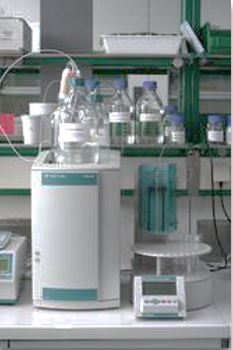Ion chromatography for determining the content of anions and cations

With the help of ion chromatography, salts in materials can be determined, e.g. as an assessment criterion of the substrate when selecting materials for further coatings such as plaster and paint. Salts that are harmful to buildings, such as nitrate, sulphate and chloride, are easily soluble in water. They can be transported through the water cycle into building materials where they can cause damage or further moisture penetration due to their hygroscopic behaviour.
Qualitative and quantitative analysis of preservatives by means of HPLC
The RMI has several liquid chromatographs (HPLC) with UV detector or diode array detector (DAD), one of which is additionally equipped with a triple quadrupole mass spectrometer. By means of HPLC, e.g. preservatives and formaldehyde can be detected qualitatively and quantitatively in coating materials, coating films and water samples. To verify that paints suitable for allergic persons are free of preservatives, pot preservatives such as isothiazolinones can be detected down to traces of 0.1 ppm. In several research projects in recent years, the RMI has worked on determining the release of substances from façade coatings into the environment via contact with dew and driving rain. The laboratory testing method was standardized as European Standard EN 16105 in order to quantify this aspectfor this purpose. State-of-the-art trace analysis methods are used for water samples from outdoor weathering or laboratory immersion tests. The water samples, so-called eluates, can be enriched with a solid phase extraction before analysis by liquid chromatography. High sensitivity and clear identification of substances in water and paint samples are achieved with the sensitive triple quadrupole mass spectrometer. With the LC/MS/MS technique, concentrations of less than one ppb of a substance can be detected in a sample even without enrichment.
* Accredited test



